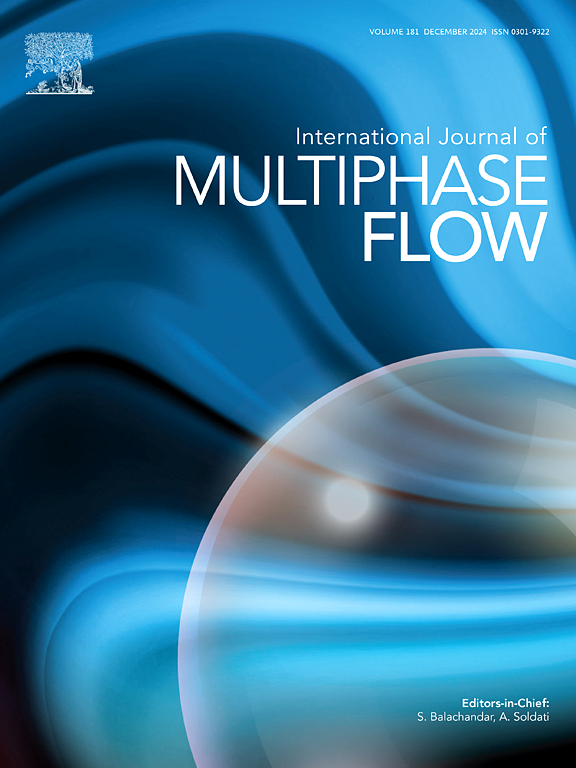Numerical investigation of Richtmyer–Meshkov instability in shock accelerated finite thickness fluid layer with particles
IF 3.6
2区 工程技术
Q1 MECHANICS
International Journal of Multiphase Flow
Pub Date : 2025-05-23
DOI:10.1016/j.ijmultiphaseflow.2025.105270
引用次数: 0
Abstract
Richtmyer–Meshkov instability in shocked fluid layer with particles is numerically investigated. Six different types of fluid layer are set up to facilitate the exploration of the effect of the presence of particles and the effect of the initial thickness of the fluid layer on the Richtmyer–Meshkov instability relating to fluid layer. The interface morphology has been affected by the large particles ( = ), leading to many “wrinkles” being formed on the interface II1, while the interface II1 and interface II2 under smaller particles ( = and = ) bear a strong resemblance to the case without particles. Moreover, the interface-coupling effect can have a certain impact on the evolution of the interface in narrow fluid layer. The presence of particles will increase the development of the mixing width during the passage of reflected shock wave due to the enhanced disturbance caused by particles and inhibit the growth of the mixing width at the late stage for the inhibition of the interface motion caused by particles. A similar RM instability evolution of small particles ( = ) has be found, however, with a discernible lag behind the carrier fluid, which is ascribed to the particle inertia. Moreover, particle concentration characteristics and classical structures such as spikes and jets manifest in the evolution of interfaces as well.
激波加速有限厚度含颗粒流体层richmyer - meshkov不稳定性数值研究
用数值方法研究了含颗粒激波流体层中的richmyer - meshkov不稳定性。建立了六种不同类型的流体层,以便探索颗粒存在的影响以及流体层初始厚度对与流体层相关的richmyer - meshkov不稳定性的影响。大颗粒(d = 40μm)影响界面形貌,导致界面II1上形成许多“褶皱”,而小颗粒(d = 5μm和d = 20μm)下的界面II1和界面II2与没有颗粒的情况非常相似。此外,界面耦合效应会对窄流层界面的演化产生一定影响。颗粒的存在会使反射激波通过时的混合宽度增大,因为颗粒的扰动增强了;颗粒的存在抑制了颗粒引起的界面运动,抑制了后期混合宽度的增大。然而,在小颗粒(d = 5μm)中也发现了类似的RM不稳定性演化,并且在载流体之后存在明显的滞后,这归因于颗粒的惯性。此外,颗粒浓度特征和尖峰、射流等经典结构也表现在界面演化中。
本文章由计算机程序翻译,如有差异,请以英文原文为准。
求助全文
约1分钟内获得全文
求助全文
来源期刊
CiteScore
7.30
自引率
10.50%
发文量
244
审稿时长
4 months
期刊介绍:
The International Journal of Multiphase Flow publishes analytical, numerical and experimental articles of lasting interest. The scope of the journal includes all aspects of mass, momentum and energy exchange phenomena among different phases such as occur in disperse flows, gas–liquid and liquid–liquid flows, flows in porous media, boiling, granular flows and others.
The journal publishes full papers, brief communications and conference announcements.

 求助内容:
求助内容: 应助结果提醒方式:
应助结果提醒方式:


